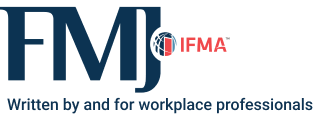Book Excerpt
Disruptive Work Places

Facility management is at a crossroads, shaped by a rapidly changing world and new expectations for the work environment. This book addresses common gaps in FM resources, which often felt too theoretical or narrow in focus. Existing literature rarely covered universal insights or practical guidance, leaving FM professionals, employees and organizations without clear paths forward. Furthermore, the pandemic fundamentally altered how people work and view FM, adding urgency to the need for practical, adaptable solutions. This book, filled with real-world use cases and expert advice from across Europe and the Middle East, provides a comprehensive, actionable guide to FM that anyone involved in the workplace can relate to and benefit from.
A central concept is the "4 Ps" framework: People, Places, Performance and Planet. Each of these aspects requires thoughtful consideration to build resilient, adaptable workplaces. Although technology and AI are becoming increasingly central to FM, it is important to remember that all advancements are ultimately for the benefit of people, who remain at the heart of this framework. The challenges of hybrid work, resource allocation, and skill shortages are shaping the FM landscape, demanding new ways of thinking. This moment is both challenging and transformative, and FMs should seize the opportunities it presents.
Sustainability in FM: moving beyond the usual suspects
One of the book’s central themes is sustainability, or the “Planet” aspect of the 4 Ps. Today, almost every organization has environmental, social and governance (ESG) goals on its agenda. Yet, FM’s approach to sustainability often focuses on a limited set of actions: installing solar panels, setting up EV charging points or reducing energy consumption. While these are valuable steps, they only scratch the surface of what FM can accomplish to contribute to a sustainable future.
Sustainable FM requires an approach that integrates technology and considers every stage of a building's life cycle. From initial design and construction to daily operations, FM can play a crucial role in creating buildings that are not only energy-efficient but also adaptable to future needs. For instance, incorporating occupancy sensors in lighting and HVAC systems can lead to significant energy savings by tailoring usage to actual demand. When technology is part of the initial design phase, organizations can create energy-neutral or even energy-generating buildings, vastly reducing their environmental impact.
A holistic approach to FM also encourages modular construction, designing spaces that can be easily repurposed or disassembled. This type of forward-thinking design supports a circular economy by reducing waste and extending the life cycle of materials. Such initiatives go far beyond cost-saving measures; they position FM as a driving force in sustainable development.
Expanding the scope of sustainable operations
Sustainability in FM also applies to operational services, such as catering. Here, the focus goes beyond reducing food waste to encompass a shift in how people think about food offerings. For instance, providing more vegetarian and vegan options can significantly reduce an organization’s carbon footprint. While it is OK to enjoy a good steak, it is important to recognize the environmental costs of meat production. By consciously adjusting catering options, organizations can contribute to a more sustainable food system.
One example is the Technical University of Delft in the Netherlands, which has integrated sustainable food practices into its operations. Their approach demonstrates how even small changes in daily operations can collectively make a substantial positive impact.
Sustainability also includes a social dimension, the "S" in ESG, which is critical for FM. One of the most pressing social challenges in FM today is the shortage of skilled operational staff. By partnering with FM service providers to recruit people who are distanced from the labor market, organizations can address talent shortages while making a meaningful social contribution. This approach expands the talent pool, filling essential roles while supporting individuals in gaining stable employment. By focusing on ESG as a whole, rather than in silos, FM professionals can contribute to a more sustainable, inclusive future.
The role of AI in shaping the future of FM
Another essential theme in the book is Performance, with a focus on the role of technology and AI in transforming FM. AI tools like ChatGPT are democratizing access to advanced technology, offering new possibilities for FM to drive efficiency and improve the workplace experience. However, there is still a prevalent question: will AI replace jobs in FM, or will it lead to an increase in unemployment? The reality is more nuanced. AI will not necessarily replace FM roles; rather, it can elevate them by taking over repetitive tasks and freeing up time for professionals to focus on more strategic work.
As AI matures, it will be able to streamline facility processes end-to-end. Digital twins, IoT and smart building systems are only the beginning. Imagine an AI system that can monitor room temperatures and trigger alerts, create work orders and assign technicians automatically, all without human intervention. Integrated systems like building management systems (BMS) and integrated workplace management systems (IWMS) are bringing these capabilities closer to reality, enabling smart decisions based on real-time data and creating seamless facility operations.
Enhancing the employee experience with AI
With organizations aiming to bring employees back to the office, AI can play a pivotal role in crafting a more engaging, personalized workplace. Just as streaming services recommend shows based on viewing history, facility management systems could use AI to offer tailored suggestions for workspace locations, meal options and even scheduling assistance. An app might suggest a workspace on a quieter floor, offer a lunch pre-order and ensure meeting rooms are booked as needed, making the office a more attractive and convenient place to be.
At the facility management service desk, AI could streamline processes further. By automating the IWMS system, FM teams can improve response times for complaints, requests and other issues. An AI-driven chatbot could manage initial inquiries, gathering data from each interaction to provide accurate, tailored answers. This not only boosts efficiency but also enhances the overall employee experience by ensuring their needs are met quickly and effectively.
Leveraging AI to address knowledge gaps
AI can also address knowledge gaps in FM by creating a continuously learning database accessible to technicians and service providers. With many organizations facing a shortage of skilled technical staff, AI-powered knowledge banks offer quick, reliable solutions to complex problems. In the future, augmented reality (AR) and virtual reality (VR) could provide technicians with on-site, real-time guidance, integrating digital twins to show step-by-step instructions or specific information about equipment. This technology supports ongoing skills development and improves operational efficiency by reducing downtime and errors.
Embracing change and moving forward
The potential of AI and sustainable FM practices is immense, but so is the journey ahead. Implementing these technologies and approaches effectively requires dedication and strategic planning. The tools are already available; the real question is how to best use them. FMs must start exploring AI applications and sustainable practices within their processes today. There is no better way to understand their value than by putting them to work.
These are just a few of the pressing challenges and opportunities facing facility management today. This book is designed to serve as a practical guide, filled with tools and insights to help FMs create sustainable and future-proof work environment. FM is uniquely positioned to lead the way to a future that balances People, Places, Performance and Planet. The evolving landscape of FM is rife with new possibilities for growth, resilience and innovation. Now is the time to act, to rethink traditional approaches and to shape the work environment of tomorrow.

Tom Ryckaert has dedicated his career to revolutionizing the way we perceive and interact with our work environments. His extensive experience spans national and international platforms, where he has collaborated with industry leaders to optimize facility and workplace environments, placing a premium on customer satisfaction and well-being. His leadership extends as a board member of IFMA Belgium where he spearheads innovation and technology initiatives, driving progress in the field of facility management.
Read more on Operations & Maintenance , Leadership & Strategy and Performance & Quality
Explore All FMJ Topics









